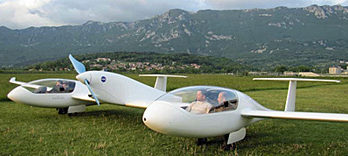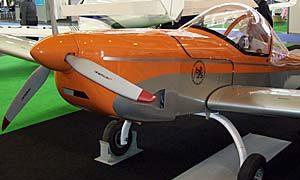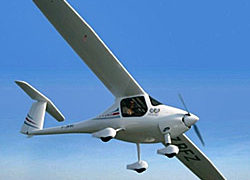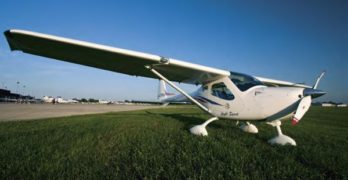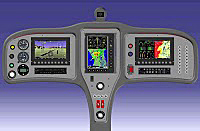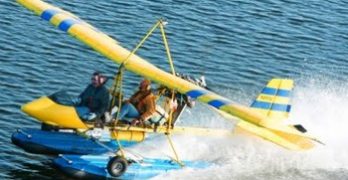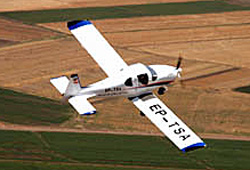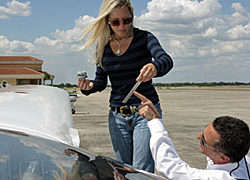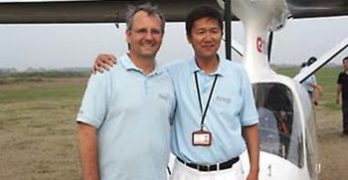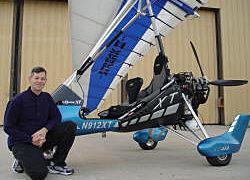Question: What looks like two motorgliders flying in really tight formation sharing an engine… er, a motor, literally between them? Can this Burt Rutan-looking aircraft (photo) win the big dough? And I mean seriously big money with a purse of $1,650,000! *** Called the Pipistrel Taurus G4, the prize-seeking aircraft rolled out of the Pipistrel factory in Slovenia for the first time recently. After posing briefly for the camera, G4 taxied away quietly under electric power for the start of the flight testing program. *** Pipistrel previously won a big NASA check with their Virus SW but the company has now taken a wholly different approach, based on rules which give seat-mile advantage to four seater models. *** “This aircraft is the first four-place electric aircraft to be flown in the world,” stated Pipistrel. Their Taurus Electro claimed to be the first two-place electric aircraft to be flown in the world four years earlier.
Search Results for : Flight Design
Not finding exactly what you expected? Try our advanced search option.
Select a manufacturer to go straight to all our content about that manufacturer.
Select an aircraft model to go straight to all our content about that model.
Aero 2011: New Single Place Aircraft
While some producers add four seaters (or more) to their LSA line, others have taken a different approach. The number of attractive new single-place models at Aero was surprising as most pilots seem to believe two seats are the minimum. *** However, for years AOPA surveys have shown the average occupancy of a GA aircraft — most of which have four seats and several models have more — is, wait for it… 1.6 persons. Given all those extra seats the 1.6 figure means a significant number of all flying is done solo. So, why pay for the extra seats when you fly solo frequently? Cost of acquisition and operation can be dramatically lower in a single seater, and you have no one else to please (or worry about) except yourself. *** I’m sure I didn’t see them all — Aero features a huge display of aircraft — but here’s a few of the new single seaters I discovered.
Triple Play: Pipistrel Wins SLSA Approvals
After a pause in new SLSA, Pipistrel burst onto the scene with multiple approvals, three at once reports Michael Coates, the importer for Pipistrel USA. We raced to get these placed on the SLSA List because it’s news, but also because FAA uses this list to verify new models before assigning them N-numbers. FAA Registration Branch checks to make sure company names and other info matches incoming applications; we had three calls last week from producers who requested minor changes to our SLSA List after the agency raised questions. *** Now that list swells to 118 models. Pipistrel, which makes long-winged models that soar well, got the Virus approved in both airplane and glider categories, no small achievement. They also gained approval for their Taurus motorglider. The Slovenian company — with production facilities in nearby Italy (partly an effort to adhere to the U.S. government’s bilateral agreement requirement… dull, yes, but important legally) — has been in the news for their electric airplanes and has announced a supersleek four seater, the Panthera.
Up-And-Comer… Remos GX
New Remos GX Rises
An LSA that was 10 years in
the making may aptly be
called a “mature design”
within this nascent sector
of piston aircraft. A few others
share a similarly “ripe, old” heritage,
but most are far newer than the trusty GA
models in which many of us learned the
art of flying.
Designed by engineer Lorenz Kreitmayr,
the first Remos G-3 took to the air
in 1997 (10 years before the upgraded GX
first flew). In 2008, N447RA, the first GX,
arrived in the States for the big summer
flyfest in Oshkosh, and that’s where I had
a chance to update my Remos experience
(previously earned in the G-3). Assisting
and educating me were two Remos reps:
National Technical Service Manager Cris
Ferguson and Managing Director of Sales
and Marketing Michael Meirer.
What’s The Difference?
While G-3 sold more than 250 copies,
performing well for European pilots for
years, the arrival of the U.S.
What Comes Next After the Remos GX?
Remos arrived in America with their G-3 model. In 2008 the company upgraded to GX. What’s next? How about the GX NXT. Did you see that coming? *** Remos Aircraft sent out advance word that its new GX NXT will debut at Oshkosh this year. The current GX Aviator II model will not be replaced. The German company’s new NXT version reflects a new instrument panel and price (base: $129,961, a significant drop from the Aviator II). *** Dynon‘s SkyView™, as on an ever-expanding number of other Light-Sport Aircraft, provides the anchor point for the streamlined new deck, which has been reworked to bring more leg room and better visibility over the nose to the cockpit. *** SkyView’s ever-upgrading software suite combines EFIS (electronic flight info system), EMS (engine monitoring system), Synthetic Vision, and Transponder in one unit. An optional second SkyView installation is available as well as Garmin 696 and Dynon autopilot.
Super Drifter: New Tail for Oldie-but-Goodie
Lockwood Aircraft‘s Super Drifter open-cockpit kitbuilt plane, the resurrection of the Drifter design that was the basic concept for Phil Lockwood’s AirCam twin-engine airplane, (a unique camera platform first created for National Geographic), is getting a new set of tailfeathers. *** I first flew a Hummer ultralight, designed by Klaus Hill, back in the fall of 1980 at Crested Butte, CO. It belonged to hang gliding pal Gil Kinzie. *** We were in CB for a soaring contest and he let several of us fly it, though most of us had no general aviation training. Ah, those wild and wooly days of free flight. *** As such, the Drifter was one of the very first viable ultralights and presented a unique flying feel to its pilots: you sat out on the end of a long fuselage keel tube with everything – wings, motor, wheels – behind you! *** Once you got over the initial floating-in-space challenges to your comfort zone, you fell in love with the incredibly open, free feeling.
Over the Horizon LSA Producers: Iran and Malaysia
Most of what our media reports about Iran is bad: Islamic militants. Contested elections. Brutal suppression of dissent. Nuclear ambitions. What we don’t hear is about the country’s light aircraft producers. Then consider Malaysia. Do you think of that country relative to aircraft production? Do you think of it in any way? My guess is most Yankee aviators haven’t given either country much thought (except maybe in a negative context). *** Yet here is Free Bird. An article appearing on Iran’s PressTV began, “Iranian aviation researchers have designed and built an all-composite ultralight aircraft to meet the country’s training, border control, surveillance and recreational needs.” The researchers are evidently employees of manufacturer H. F. Dorna Company, which “was established in Tehran in 1988 as a private company specializing in design and manufacture of light-sport aircraft.” *** Managing director of H. F. Dorna, Yaghoub Entesari, was reported as saying, “[Free Bird’s] full composite structure conforms to ASTM technical standards and falls under the micro-light category under Iranian law.” Free Bird is said to fly more than 500 miles with a maximum airspeed in level flight of more than 150 mph (which is beyond FAA’s LSA rules).
650 Million Engines & the Promise of “Sport Fuel”
As the battle rages on regarding a replacement fuel for 100 LL avgas, sport aviation enthusiasts already have another, cheaper fuel option. The best news is they potentially have an enormous support group (even bigger than Facebook, if you’ll permit that comparison). Here’s what blogger Kent Misegades wrote… *** “Consider these numbers: According to GAMA, there are approximately 165,000 piston-engine aircraft registered today in the United States. Since 1982, some 65,000 autogas STCs have been sold by Petersen Aviation and the EAA. A growing part of the GA fleet, America now has around 2,000 new SLSA (and many thousands more ELSA) registered. Nearly all of these use engines designed to run on autogas. Fuel is sold at approximately 3,500 FBOs on the 13,000+ airports registered in the country. Autogas is currently sold at just 100 of these airports.” (Talk about your missed opportunities! —DJ). *** “By contrast, in 2006, the U.S.
Electric Prototype and Pilot Lost
As I write an article on the current state of electric flight worldwide, sad word comes that prolific, talented German aeronautical engineer Martin Wezel has died in the crash of the prototype Yuneec International E1000 electric airplane. *** Wezel’s company, Flugzeugtechnik Wezel, was well respected for its gliders and microlights, which included the Sting and Sirius SLSA. His Apis and Viva designs were also being developed by Yuneec for electric power. The E1000 design may also have been Wezel’s. *** A new, tandem-motored four-seat design, it was being developed for market by Yuneec but also to compete in the NASA CAFE Green Flight Challenge, the $1.65 million-prize competition that’s coming up in July. *** E1000 was also entered in EAA’s upcoming Electric Aircraft Competition (Oshkosh 2011 in late July). Not evident at this point is whether another E1000 was built or will be tested.
How Important Is FAA Oversight of LSA?
Weight shift instructor and FAA Designated Airworthiness Representative (DAR) Terri Sipantzi wrote an excellent editorial about the FAA’s plan to start inspecting new SLSA or new companies producing LSA. Terri’s piece was well written and accurate. He quoted me but I find it surprising to be the only one publicly talking about this matter even though FAA has said (at AirVenture 2009) that they would be doing more inspections. This is not new information. I am merely beating the drum louder as FAA gets closer to doing what they said they would do. *** Yet Terri left out an important point… Industry could provide such oversight. In fact, I believe industry oversight could be the more effective method to increase compliance and potentially therefore safety, which — to put a fine point on it — is the ultimate goal of certification schemes. All these parts — standards, certification oversight, manufacturing best practices, quality control systems, third party audits — have one purpose: Safety.
- « Previous Page
- 1
- …
- 99
- 100
- 101
- 102
- 103
- …
- 147
- Next Page »


